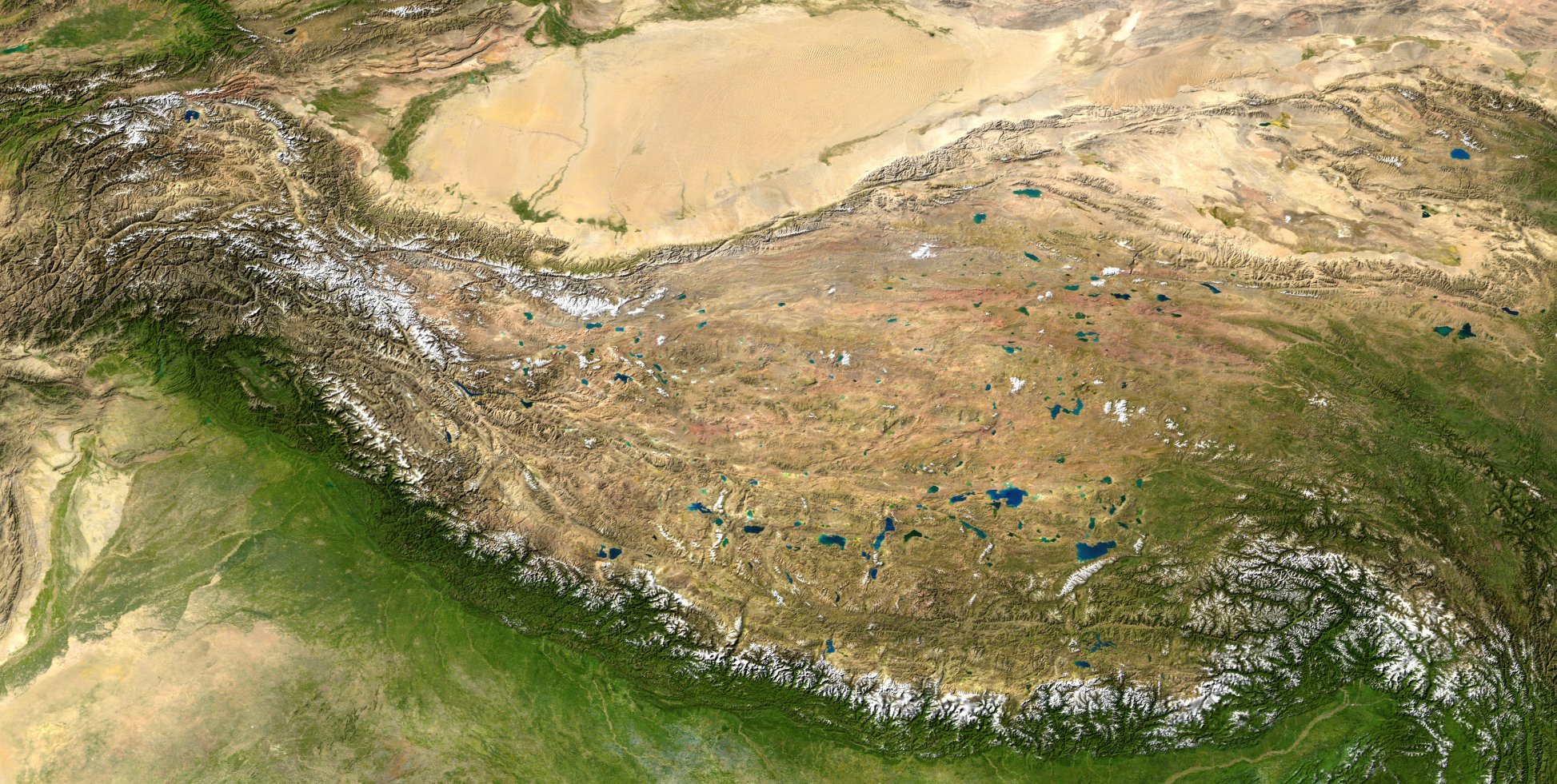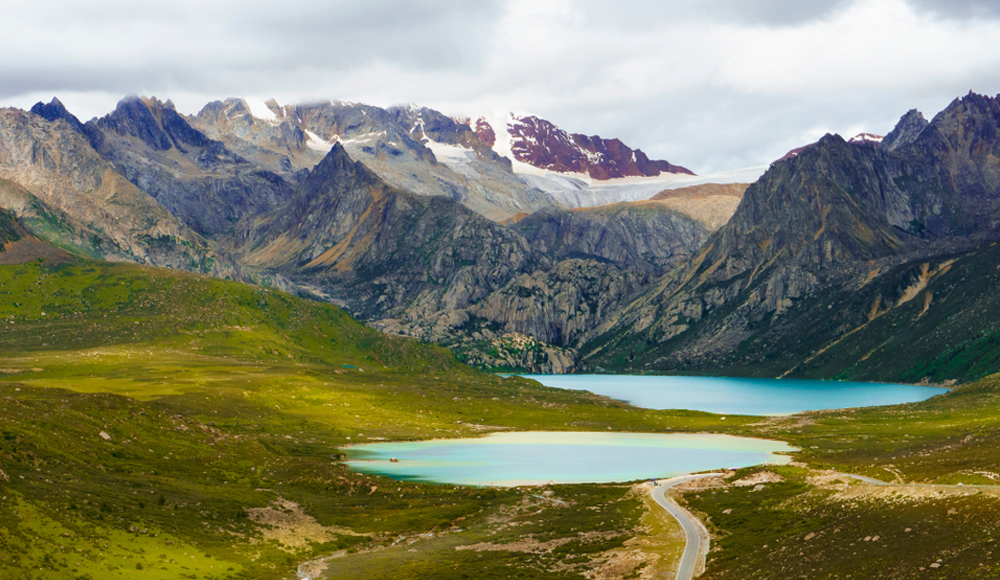How Recent Tibetan Plateau Uplift Enhanced Vegetation
Considering Earth’s long geological history, the Tibetan Plateau is a never-before-seen geographical feature (see figure). We are living during a unique time when a landmass of a million square miles (2.6 million square kilometers) manifests an average elevation of 15,100 feet (4,600 meters) above sea level. This very high average elevation explains the Tibetan Plateau’s appellation as the “roof of the world.” Recent research reveals that construction of this “roof” appears to be purposely designed for humanity’s benefit.

The Himalayan mountain range stretches across the bottom of the image. Slightly left of top center is the Taklamakan Desert. In between is the Tibetan Plateau.
Diagram credit: NASA
In my books Improbable Planet1 and Weathering Climate Change,2 I wrote about the Tibetan Plateau’s crucial role in initiating our current ice age cycle. In those books I also describe the benefits we accrue from being in an ice age cycle at a time when the Sun, brighter than it has been during life’s history, is in its most stable luminosity phase.3
Now, a research study by fourteen geologists and ecologists from China, the United Kingdom, the United States, and Germany led by Shu-Feng Li reveals yet another benefit we garner from the unprecedented and continuing rise of the Tibetan Plateau.4 Before describing their research findings, let me first address what initiated the rise of the Tibetan Plateau.
Colliding Plates Have Raised the Plateau
The high-velocity tectonic collision (20 centimeters per year) between the Indian subcontinent tectonic plate and the Eurasian tectonic plate that began about 50 million years ago created the Himalayan mountain range and pushed up the region north of the Himalayas. The collision is ongoing. It has slowed down to 5 centimeters per year, a rate that nevertheless is more than twice as fast as normally rapid plate tectonic movements.
A Rising Plateau Changed Vegetation
Li’s research team used numerical modeling to conduct 18 sensitivity experiments based on different Tibetan topographies representing various late Paleogene (a period spanning 66 to 23 million years ago) to early Neogene (23 to 2.6 million years ago) conditions. Their goal was to directly examine the impact of the rise of the Tibetan Plateau on the development of vegetation observed to have occurred in eastern and southeastern Asia throughout the past 50 million years. 5 They used a sophisticated atmosphere model known as HadAM3 to reach their goal.6
The team established that the ongoing rise of the Tibetan Plateau, especially that part of the plateau in north and northeastern Tibet, dramatically changed vegetation in eastern China, southeast Asia, and India by altering the Asian monsoon systems. In particular, the Tibetan Plateau rise induced a huge precipitation increase, especially in what was the dry winter season.
Two important vegetation changes occurred. The first was a transition from deciduous (leaf-shedding) broadleaf to evergreen (non-leaf-shedding) broadleaf vegetation throughout China, India, and Southeast Asia. The second was a huge increase in plant biodiversity across all of Southeast Asia.
The team’s research reveals significant design implications. Without these two vegetation changes, it would not be possible for half the world’s human population of 7.8 billion people to live in China, India, and Southeast Asia with adequate indigenous food resources. Their analysis also provides evidence that Earth’s geological history has been exquisitely fine-tuned to make possible the existence of billions of human beings and the purpose for which they were created.

Credit: StateStreet, Creative Commons Attribution
ENDNOTES
- Hugh Ross, Improbable Planet (Grand Rapids, MI: Baker Books, 2016), 203–04.
- Hugh Ross, Weathering Climate Change (Covina, CA: RTB Press, 2020), 137–40, 145–47, 236.
- Ross, Improbable Planet, 209–12; Ross, Weathering Climate Change, 81–93.
- Shu-Feng Li et al., “Orographic Evolution of Northern Tibet Shaped Vegetation and Plant Diversity in Eastern Asia,” Science Advances 7, no. 5 (January 27, 2021): id. eabc7741, doi:10.1126/sciadv.abc7741.
- Dale Lunt, Rachel Flecker, and Peter D. Clift, “The Impacts of Tibetan Uplift on Palaeoclimate Proxies,” Geological Society of London Special Publication 342 (August 2010): 279–91, doi:10.1144/SP342.16; Ran Zhang, Dabang Jiang, and Zhongshi Zhang, “Vegetation and Ocean Feedbacks on the Asian Climate Response to the Uplift of the Tibetan Plateau,” Journal of Geophysical Research: Atmospheres 124, no. 12 (June 27, 2019): 6237–41, doi:10.1029/2019JD030503.
- Paul J. Valdes et al., “The BRIDGE HadCM3 Family of Climate Models: HadCM3@Bristol v1.0,” Geoscientific Model Development Discussions 10 (February 2017): 3715–43, doi: 10.5194/gmd-2017-16.






